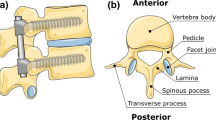We present a method of minimally invasive transcutaneous insertion of screws using a prefabricated extracorporeal navigation system using additive technologies (based on primary data obtained from the DICOM package in multi-detector computed tomography of the affected spine segment) according to the principle of personalized medicine. The method was tested on 10 dogs of different breeds with generally similar mechanism of trauma and typical consequences that led to fracture and dislocation of one of the lumbar vertebrae. In all animals, a positive treatment outcome of different degrees was achieved. Regression of the neurological deficit without significant postoperative inflammatory reaction was noted. The proposed method of treatment reduces the risk of malposition in pedicular and interbody pins and reduces radiation intraoperative exposure.
Similar content being viewed by others
References
Mikhailovskii MV, Ramikh EA, Rerikh VV, Sadovoi MA. Spinal injuries. Traumatology: the National Guide. Kotel’nikov GP, Mironov SP, eds. Moscow, 2011. P. 799-874. Russian.
Bergyugin KA, Berdyugina OV. Description of the utility model for patent no. RU 101908U1. A guide for transpedicular screw placement during transcutaneous osteosynthesis of the spine. Published February 10, 2011. Russian.
Perlmutter OA. Trauma of the Spine and Spinal Cord. Nizhny Novgorod, 2000. Russian.
Yushkov BG, Chereshnev VA. The Concept of Norm in Physiology: Physiological Constants of Laboratory Animals. Moscow, 2016. Russian.
Berry E, Cuppone M, Porada S, Millner PA, Rao A, Chiverton N, Seedhom BB. Personalized image-based templates for intra-operative guidance. Proc. Inst. Mech. Eng. H. 2005; 219(2):111-118.
Kaneyama S, Sugawara T, Sumi M, Higashiyama N, Takabatake M, Mizoi K. A novel screw guiding method with a screw guide template system for posterior C-2 fixation: clinical article. J. Neurosurg. Spine. 2014;21(2):231-238. doi: https://doi.org/10.3171/2014.3.SPINE13730
Mobbs RJ, Coughlan M, Thompson R, Sutterlin CE 3rd, Phan K. The utility of 3D printing for surgical planning and patient-specific implant design for complex spinal pathologies: case report. J. Neurosurg. Spine. 2017;26(4):513-518. doi: https://doi.org/10.3171/2016.9.SPINE16371
Author information
Authors and Affiliations
Corresponding author
Additional information
Translated from Byulleten’ Eksperimental’noi Biologii i Meditsiny, Vol. 168, No. 12, pp. 788-792, December, 2019
Rights and permissions
About this article
Cite this article
Dotsenko, I.A., Kotomtsev, V.V., Medvinsky, I.D. et al. Method of Surgical Treatment of Spine Injury with the Use of Extracorporeal Navigation System Based on Additive Technologies. Bull Exp Biol Med 168, 821–825 (2020). https://doi.org/10.1007/s10517-020-04810-z
Received:
Published:
Issue Date:
DOI: https://doi.org/10.1007/s10517-020-04810-z




